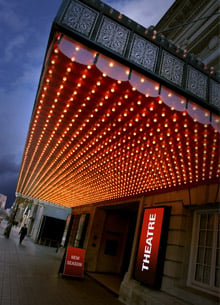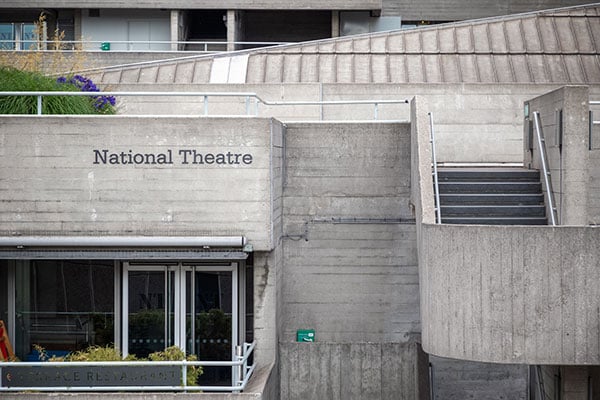
Learn all about protecting your theatre company and the theatrical performances that happen within it! This eBook includes helpful information on:
There is nothing like a night out at the theatre.
 Getting dressed up in a fine outfit. Hiring a babysitter for the kids. And being swept away in a dark room that allows you to forget about real life, if only for a few hours, is well worth the price of admission. The idea that anything could shatter the illusion is unconscionable. “What could ever go wrong?” you might ask. At a UK production of “Grumpy Old Women,” the audience found out the hard way.
Getting dressed up in a fine outfit. Hiring a babysitter for the kids. And being swept away in a dark room that allows you to forget about real life, if only for a few hours, is well worth the price of admission. The idea that anything could shatter the illusion is unconscionable. “What could ever go wrong?” you might ask. At a UK production of “Grumpy Old Women,” the audience found out the hard way.
At Cheltenham’s Everyman Theatre, the audience was evacuated due to a pyrotechnic mishap that occurred well before intermission. Frustrated theatre goers spilled out onto nearby Regent street as firemen arrived promptly at the scene. Despite its challenges, like many great stories of the theatre, this one has a happy ending.
Ultimately the fire was put out and the show went on as planned. Since we’re in the insurance industry however, let’s have a look at some hypotheticals.
More than almost any other hazard, fire shows just how important it is that a theatre carry good production liability insurance. Had the pyrotechnic mishap gotten out of control the damage to property and more importantly people could have been immeasurable. While key person insurance would have protected the lead actors, and the company’s theatre insurance would have covered sets, and costumes, without the proper liability limits an out-of-control fire is enough to draw the curtain on any business due to its potential to cause personal injury. Furthermore one production’s damage to a theatre has implications for said theatres future productions and revenue streams, all of which need to be protected.
A Christmas pantomime of Jack and the Beanstalk was cut short after an actor twisted his ankle in the middle of a performance. The actor’s name is Edward York and he plays the role of “Squire Snuffbox”–a detail his father keeps from the other retirees at the racetrack. An ambulance was called and an emergency crew arrived at the scene to escort the actor to the hospital. Of course the show had to be cancelled in the middle of a performance. Let’s take a look at how Theatre Insurance can come to the rescue in such an occurrence.
As part of the Theatre Insurance for its season, there is no question that “Theatr Clwyd” would have cancellation insurance that would replace income lost by the unfortunate accident. Every audience member would want their money back and some might even be tourists incapable of seeing a future show. There is also the question of just how big a part of the play “Squire Snuffbox” actually was. If he was a major character without an understudy, Theatre Insurance would cover the cost of replacing him. If he was a minor player, perhaps the show could go on without him for a time.
Finally there is the issue of medical expenses. If “Theatr Clwyd” had purchased cast medical coverage under their theatre insurance, any of Squire Snuffbox’s sore ankle expenses would be taken care of.
(exhale) So there you have it, folks. A Christmas Tragedy and it’ll take a lot more than 3 ghosts to fix this one.
 London’s National Theatre | Shutterstock Royalty-free stock photo ID: 1164426331.
London’s National Theatre | Shutterstock Royalty-free stock photo ID: 1164426331.
This post reviews some infamous theatrical stage disasters that have happened over the years. We cannot guarantee that any of these disasters would have necessarily been covered under any insurance claim (coverage decisions are ultimately up to the insurance company), but it is nonetheless instructive to consider what has gone wrong during past live productions – and how insurance might have been helpful – especially if you work in the theatre world.
In 1613, the Globe Theatre in London burnt to the ground. This was the theatre where most of Shakespeare’s plays debuted, including The Tempest.
How did it happen?
A theatrical cannon – set off during a performance of All is True/Henry VIII – misfired, igniting the wooden beams and roof. There were no reports of any injuries.
A year later the theatre was rebuilt, only to be eventually demolished by the Puritans on ideological grounds.
This tragedy was the deadliest theatre fire and the deadliest single-building fire in US history, resulting in at least 602 deaths.
How did it happen?
During a matinee of the musical Mr. Blue Beard, sparks from an arc light ignited a curtain, probably as a result of an electrical short circuit. The fire spread quickly from there and those in the crowded theatre began to panic and flee, but this resulted in a human stampede of sorts, and many weren’t able to get out alive.
During a rehearsal of the play Way Upstream – which is set on a cabin cruiser boat on an English river – at London’s National Theatre in 1982, the water tank simulating the river burst. This flooded the National Theatre.
How did it happen?
The National had constructed a 6,000-gallon tank to hold the boat; the tank eventually split and deluged the stage machinery. The boat had been weighed down by a dozen people, half of them stage crew, at the time of the flood.
Each of our Theatre Insurance policies is customized to fit your unique exposures. From people, property and productions to administration and financing, we work with you to develop unique risk protection including Dance Liability Insurance, Opera Insurance or Performing Arts Insurance. To cover everything you do.
Canadian Theatre Producers: Insurance program can be purchased online for up to 4-weeks of coverage:
“You got it buddy, the large print giveth and the small print taketh away”
― Tom Waits, Step Right Up

In the nearly 30 years I’ve been a theatre insurance broker, I’ve read many theatre insurance policies. Over those years, I’ve adopted an approach to help me determine what’s covered and what’s not, relatively quickly.
In today’s post, I thought I would share these very simple tips with you. They will make you feel more comfortable with the policy you are buying and help you form better questions when discussing the coverage with your broker or dealing with a claim.
Before we begin, it’s important to know there are four essential parts of any Theatre Insurance Policy. For the purpose of this discussion, I will be referring to a "Broad Form" type of policy (often referred to as an ‘All Risks’ policy; a terrible name by the way, as I’ve yet to see a policy that covers everything!) This type of policy has become the most common in the industry and is generally considered a broader form of coverage than a ‘Specified or Named Perils’ policy. Broad Form policies outline what type of claims you will NOT be insured against; whereas, a Specified Perils policy outlines the types of claims which are insured by the policy.
So here we go:

One of the delights of the circus is seeing the most skilled acrobats dazzle an audience with risky stunts. At cultureONE our experience with production liability insurance and special event liability insurance has shown that there are always unfortunate exceptions where even the most skilled acrobat doesn’t escape danger as planned.
One such incident occurred recently at a Ringling Bros. Circus in Rhode Island where an aerial accident sent eight performers plummeting to the ground. The stunt, known as “the human chandelier” involved performers hanging from their hair on a suspended apparatus. A clip at the top of the apparatus snapped and three performers are at the hospital in serious condition. Thus far there is no conclusive information as to why the clip failed.
When quoting theatrical insurance where aerial stunts are being performed, one of the questions we always ask is how much experience the aerial rigging technician has. We also ask if he/she is licensed. This protects the risk and encourages producers to employ the best people. Furthermore we offer key person insurance. This is reserved for parties whose inability to perform would result in the event being cancelled. In an event like the circus, the specialized skill on display makes purchasing the above coverages a must, and our years of experience will make sure there are no gaps that might hinder a major performance.
If you thrill audiences with outrageously creative performances and produce shows that awe everyone from children to corporate suits, you know there are very real risks involved in your productions.
Aerialists, high wire walkers, acrobats, contortionists – every act you can think of has been thought of by us. We can help you sleep well at night, knowing you are properly insured.
Created using our actONE program, we will provide you with seamless insurance coverage from the moment you begin your project until the applause of closing night.
As an owner or operator of a dance company, having the proper insurance and risk management solutions will keep the show going. Based on 25 years of experience insuring and supporting the performing arts, actONE will cover you from the moment you begin your project till the applause of closing night.
Canadian Theatre Producers: Insurance program can be purchased online for up to 4-weeks of coverage:
Each of our dance performer insurance policies is customized to fit your unique exposures. From people, property and productions to administration and financing, we work with you to develop unique risk protection for your dance company.
The cost is as low as $750.
As operator of an Opera company, having the proper insurance and risk management solutions will keep the show going. Based on 25 years of experience insuring and supporting the performing arts, actONE will cover you from the moment you begin your project till the applause of closing night.
Each of our opera insurance policies are customized to fit your unique exposures. From people, property and productions to administration and financing, we work with you to develop unique risk protection for your opera company.
The cost is as low as $750.
Designed to provide producers theatre insurance, dance insurance and opera insurance, actONE is a specialized arts insurance policy that provides seamless insurance coverage from the moment you begin your project until the applause of closing night. 
Theatrical property sets, costumes, cameras, computers & office equipment as well as rented or borrowed theatrical equipment such as lights & sound
Sexual abuse and harassment protection
Actors', volunteers' and employees' personal property in theatres or rehearsal spaces
Theatrical performance disruption for interruption, postponement, cancellation, or impairment of your performances caused by circumstances which are beyond your control
Theatrical venue and tenants’ legal liability to insure damage you cause to a venue, rehearsal space or any other premise
Crime-related insurance dishonesty, theft of money, fraud or forgery
Theatrical liability for claims related to bodily injury or property damage to another party including legal defense costs
Catastrophic cast indemnity for delays, interruptions, postponements, cancellation of a production or performance due to injury, sickness or permanent total disability or death affecting one-third of your cast
Travel delay coverage when severe weather conditions or mechanical breakdown of vehicles prevent your cast from being able to travel to a venue
Non-owned automobiles for the use of automobiles in your production
(D&O insurance webinar for arts group BC Alliance for Arts + Culture, February 2020)
What are you responsible for when you act as a director on a non-profit arts board: how can D&O insurance protect you?
Know that Directors can be held liable for acts committed by other Directors, simply because they sit on the same board. Such damages can extend to the entire personal estate of the Director involved.
Canadian directors and officers insurance should be a requirement before you decide to join a non-profit board. The Canada Business Corporation Act imposes many responsibilities on a Director or an art group board – even if they are volunteer. The breach of any of the responsibilities, if it leads to financial loss to the arts group, can be grounds for an action for damages. Many of these risks can be transferred through D&O insurance.
It is not uncommon for many claims to be unjustified or unfounded; however, the costs associated with their investigation and defense are often substantial. Our D&O insurance for arts groups will provide money for defense costs.

Here’s a scenario:
You successfully pitched the project, secured the financing, cast a couple of great lead actors in the roles and now you need to get all of the other pieces in place for the show. Of course you need some production insurance, and on this show you want some Cast Insurance on your two leads. They’re both integral to the show and it would bad for you and your investors if an illness, injury, or worse, was to prevent one or both of them from appearing. It’s not a long run; scheduling will make it hard to extend it, so insurance is the way to go to cover the financial exposure of something going wrong with the actors.
You connect with the broker and he tells you a medical will be required on each actor. You think, “No problem - both are young and healthy”, but your contract with them doesn’t say anything about insurance. One of their agents pushes back, but in the end it’s agreed that the actor will see the doctor.
The medical is received, but … (as the reader, I’m sure you knew there was going to be a ‘but’ coming) … when the insurance company reviews it, they make note of a history of a medical condition that concerns them. The underwriter researches it and speaks with her company’s consulting physician and learns that the condition is exacerbated by stress and can really flair up if the person becomes fatigued. This is a rigorous and physical show with 6 shows a week. You begin to be concerned.
The insurers decide this is a risk they don’t want to insure. Now your concern elevates. The financial risk is high and, if the health condition becomes an issue, you will likely need to cancel the show as there won’t be time to re-cast and rehearse a new actor into the remaining scheduled performances.
As a broker, I have seen this scenario play out many times. So how can it be avoided? What are the steps a Producer can take to protect themselves from facing a major insurance policy exclusion that leaves them with a big financial exposure?
I recommend that Producers start thinking about Cast Insurance when they are budgeting their show. If you aren’t able to work the cost of understudies or swings into your budget, or if the success of the run could be affected by the loss of a lead-role actor, then you should be including Cast Insurance as a line item in your show budget.
Betty Grable was known as the "Girl with the Million-Dollar Legs" because that's what Fox Studios requested from Lloyd's of London for the Body Parts Insurance policy. Grable was once quoted to have said, "There are two reasons why I am successful in show business and I am standing on both of them." Grable knew her legs were something to be admired. Most ordinary people wouldn't need this type of insurance, but those who have careers based on their appearance or performance might need body part insurance coverage.
There are rumours that Jennifer Lopez insures her rear-end for a billion-bucks, although she denies it. Anyone with a body part that valuable shouldn't go around advertising it.
There are reports throughout the history of the entertainment business of celebrities insuring a variety of body parts.
 The earliest reports of body part insurance come from the 1920s, when a policy insuring silent movie star Ben Turpin's signature crossed eyes from the risk of going straight was issued. It might seem odd anyone famous for crossed eyes could make it big in the first place but, the fact Turpin took out insurance protecting his asset is rather interesting.
The earliest reports of body part insurance come from the 1920s, when a policy insuring silent movie star Ben Turpin's signature crossed eyes from the risk of going straight was issued. It might seem odd anyone famous for crossed eyes could make it big in the first place but, the fact Turpin took out insurance protecting his asset is rather interesting.
Insurance is a contract binding an insurer to indemnify someone against a specific loss in return for a premium. There needs to be a value for the asset being insured and most of us generally think insurance would cover losses suffered from some kind of disaster. Well, when you think about it, celebrities need body part insurance if their asset is their own rump. What would they have if something happened back there? A disaster!

Society entrusts teachers with its most precious resource: our children.
For schools and instructors who teach the arts, this responsibility comes with additional risks, such as bodily injury from a performance, property damage in a studio, or abuse.
As the go-to insurance partner for the arts industry in Canada, Front Row understands the challenges faced by individuals and institutions working in arts education and the unique solutions they require.
Whether you are a private instructor, studio owner, educational institution, Protégé has a solution to cover your specific needs.
Our policies are straightforward and affordable and our specialists are available to ensure you have the protection you need so that you can focus on what you do best: bringing the joy of art into people's lives.
CONTACT US TODAY TO RECEIVE A NO COMMITMENT QUOTE:
Or read on below for more details on Protégé coverage

The priority for all schools and teachers must be the safety of the students that are entrusted to their care. A lot of research has been done over the last few years as to how we can all practice a higher standard of responsibility in that regard and as a consequence, school administrators and owners are expected to demonstrate a ‘duty of care’. One recommendation is to establish a safeguarding policy for your school. Not only will this demonstrate your commitment to the well-being of your students, but should there be an insurance claim it could be helpful to show you have a set of standards and procedures acknowledged by all staff.
Before you begin to draft your policy, consider the following questions because the answers will help shape the final document: What are the potential risks to the children? Who may pose that risk and what situations might increase the risk? How will you check the backgrounds of your volunteers and staff? How will you respond to allegations of concern or harm?
When you start to write your policy, name your organization and then state the purpose and aim of the policy. Provide a link to the law that supports the policy and explain how the policy relates to the business’s procedures around taking photographs or videos, internet use, recruitment, etc. Include an equality statement that commits to anti-discriminatory practice and clarify the scope of the policy – will it apply only to staff and volunteers who have contact with the children, or other people, like a janitor? Finally, identify review dates, so the policy can be updated at regular intervals.
Once this has been done, make sure you have specialty art school insurance for arts educators in place, like the Protégé Program, offered by Front Row Insurance Brokers. Front Row is the premier brokerage in Canada for coverage in the performing arts and supports a number of national and provincial organizations like PACT and Dance Ontario. Protégé comes out of their realization that insurance expertise should be available for small studio owners as well as the large organizations. They know their stuff and provide coverage through a quick online service at very little cost.

Your school will be filled with joyous events that mark the achievements of your teachers and their students. Of course everyone will want to commemorate these milestones and there is often only a split second between the taking of a wonderful photo or performance video and the posting of that same pic to the internet. It will often include class members. An arts educator or studio owner should stop and think about this. No one wants a picture of their child floating around the internet, so how can you help your students and their families share their joy while safeguarding your students’ privacy?
Developing a broad-based policy around safeguarding your students, see Part 1, will help you to add a section on filming and photographing students that is consistent with your operating principles. Make sure your parents and staff sign an agreement that includes a commitment not to identify students by name in any photo and have a signed consent form by the parents on file in case professional photographers are brought in. Naturally the photographers should sign an agreement also and should never be left alone with the students. For promotional purposes on a website, for example, it might be best to use commercial stock photos.
If images remain in your possession, store hard copies in a locked drawer and electronic copies in a protected folder with restricted access. Do not store them on unencrypted devices, like a mobile phone or laptop. If you issue photo ID cards, make sure you comply with any data protection legislation.
Small mistakes can have big repercussions, so once you have your policy and practice in place and have explained everything to your instructors, staff, parents and students, make sure your Protégé insurance policy is in effect to safeguard you and your business against an allegation of improper behavior. Your students are precious and so is your studio.

Hiring an Intimacy Coach, or Intimacy Director (ID), as part of a theatre’s crew is becoming more common in Canadian theatrical circles, sparked by media attention to the vulnerability of women in the arts and entertainment sector.
So what is the purpose of an Intimacy Director, and how can one be helpful to all members of a cast and crew, not just the female actors?
An ID’s job is to make the performers and crew feel protected while staging scenes that can create anxieties around the portrayal of acts of sexual violence, nudity, or other forms of intimacy. This is done when the ID establishes clear paths of communication for the rehearsal and show, and demonstrates best practices for creating a healthy performance space, as well as actually choreographing scenes of intimacy.
A first step for the coordinator is to have a conversation with the individuals closely involved in developing the scene, like the director and actor, to gauge feelings of concern. Under the pressure of landing and maintaining a job, it is too easy for artists to feel they have to agree to perform acts they aren’t comfortable with.
It is the ID’s role to establish confidence in the process and then choreograph the scene in a way which conveys the storyline without breaking the bond of trust between the director, actor, producer, and crew. This can be particularly important in the realm of live theatre as the performances must feel authentic each time the play is performed.
If the actor has felt psychologically pressured or even coerced into a place of discomfort, the acting and the entire production can suffer. The buffer that the ID provides is another step toward the smooth performances and safe sets theatrical producers need.
Learn all about protecting your theatre company and the theatrical performances that happen within it! This eBook includes helpful information on:
DISCLAIMER: Informational statements regarding insurance coverage are for general description purposes only. These statements do not amend, modify or supplement any insurance policy. Consult the actual policy or your broker for details regarding terms, conditions, coverage, exclusions, products, services and programs which may be available to you. Your eligibility for particular products and services is subject to the final determination of underwriting qualifications and acceptance by the insurance underwriting company providing such products or services. This website does not make any representations that coverage does or does not exist for any particular claim or loss, or type of claim or loss, under any policy. Whether coverage exists or does not exist for any particular claim or loss under any policy depends on the facts and circumstances involved in the claim or loss and all applicable policy wording.
Amazon Associates Disclosure: Front Row Insurance is a participant in the Amazon Services LLC Associates Program, an affiliate advertising program designed to provide a means for sites to earn advertising fees by advertising and linking to Amazon. This post may contain affiliate links. There is no additional cost to you.